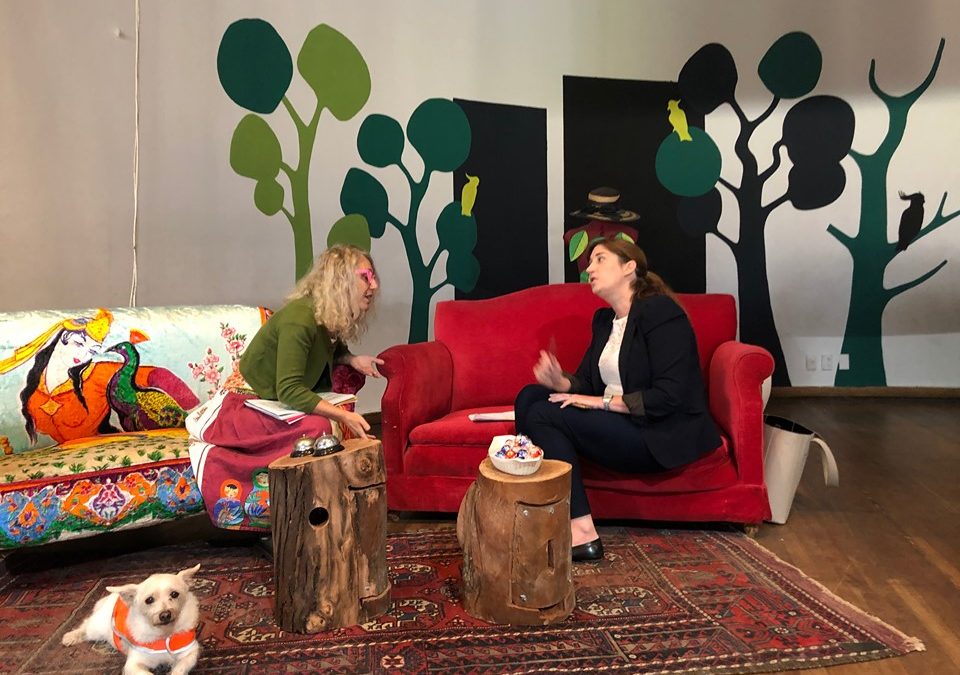Rosanna Barbero, CEO of Addison Road Community Centre Organisation, in pre-conference conversation with Councillor Anna York, Inner West Council. Rethinking the Urban Forest. Photo by Mark Mordue.
*
Nathan Moran, the Chief Executive Officer for the Metropolitan Aboriginal Land Council in Sydney, gave a powerful Welcome to Country and an affecting and personal reflection on indigenous land management to a packed room at the Rethinking the Urban Forest conference.
The conference brought together all kinds of theorists and practitioners – from scientists through to arborists, from ecologists through to architects, artists, urban planners and politicians – mixing and uniting their visions for greener, better cities. Nearly 30 speakers and over 180 delegates from all over the city, and indeed the country, arrived to share their ideas and experiences.
Moran’s recollections of speaking with elders who remembered what the land had been like around Sydney, and what had happened to it in living memory, was more than enough to charge the atmosphere and set an inspired tone of urgency to proceedings.
Initiated by the Addison Road Community Centre Organisation in Marrickville, Rethinking the Urban Forest was formally opened by Addi Road’s CEO, Rosanna Barbero. In her address, Barbero stated, “It’s important to answer the question I’ve been asked a few times when people have wondered why Addi Road has got behind creating and hosting this conference.”
“The answer is we see the integral links between climate crisis and social inequality. Models of unsustainable development can no longer continue,” she said. “We need a more civil society, and for government at every level to address community concerns. This event and its ambitions are fundamental our charter: ‘to help create lasting alternatives for social, economic and environmental justice’.”
Barbero pointed to the work the Addison Road Community Centre Organisation was engaged with through its Food Pantry project, “rescuing a 100 tonnes of food and feeding 1200 families every week”. She observed that the conference’s mission to ‘upscale the urban forest’ and enhance our environment for all living creatures, improving our mental and physiological well-being along the way, was entirely consistent with the mission of the Addison Road Community Centre Organisation.
Councillor Anna York of the Inner West Council agreed with Barbero. “The climate emergency crisis calls on all of us to act as quickly as we can in all our areas.” Citing the lyrics to the Paul Kelly and Kev Carmody song, she said, “It’s true for all of us here today that ‘from little things, big things grow’.”
*
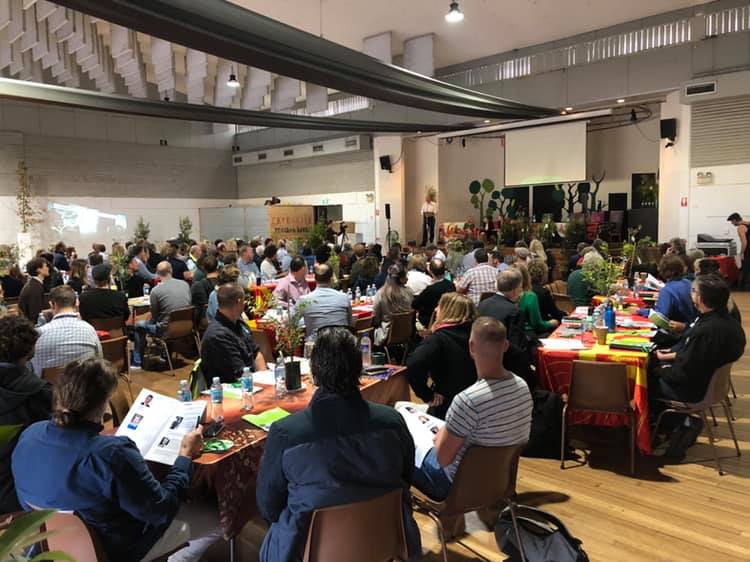
Nathan Moran, Chief Executive Officer for the Metropolitan Aborigjnal Land Council in Sydney, gives a Welcome to Country for ‘Rethinking the Urban Forest’ conference.

“Have you got the program yet?” Rose Porter and Jayda Bicer at Rethinking the Urban Forest.
*
Our first panel for the day was ‘The Threats and Opportunities for Rethinking the Urban Forest’. Abby Mellick Lopes, Senior Lecturer in Design and Researcher at the Institute for Culture and Society at Western Sydney University, warned that, “Cooling happens in private spaces. This mostly means air-con and greenhouse emissions when it’s hot.”
“We already spend almost 90% of our time indoors on average, including our time in cars,” she said. “We are heading towards 50 degrees summer days by mid-century. Before the mid-century if you look at temperatures being reached in places like Penrith last summer.”
Lopes then referred to a purple-stained heat map projected on to an overhead screen. “What we are seeing with [temperature] maps is an economic and spatial inequality emerging.”
In other words, where you live will increasingly determine your capacity to move around as the summers get hotter and hotter. In the western suburbs of Sydney that problem is going to become worse without a concerted effort to “cool the commons”, as Lopes puts it.
More trees are desperately needed. And different approaches to planting them, including moving beyond “this habit we have of always planting trees in a single row,” Lopes said with comic exasperation. “We need copses of trees too.”
*
Councillor Jess Miller of City of Sydney said it was important “a community centre have put their hands up to host a day like this”.
“Living structure is essential infrastructure” and needs to be better understood and incorporated into decisions affecting place and community everywhere. High level political failure to appreciate this was self-evident. “The fact no Minister for Infrastructure or Shadow Minister for Infrastructure is here speaks volumes,” Miller said.
It means community action becomes more important than ever. Miller alerted people to ‘Local Planning Strategy’ platforms being developed by many local councils NOW. These plans will “effectively determine whether or not you get enough green space in your areas for the next 10 years!”
What is your council’s ‘Local Planning Strategy’ for trees and green spaces? Have you any concerns or suggestions locally? Miller suggested you better start phoning your council and enquire. Or the next decade will be decided for your community before you even know it.
*
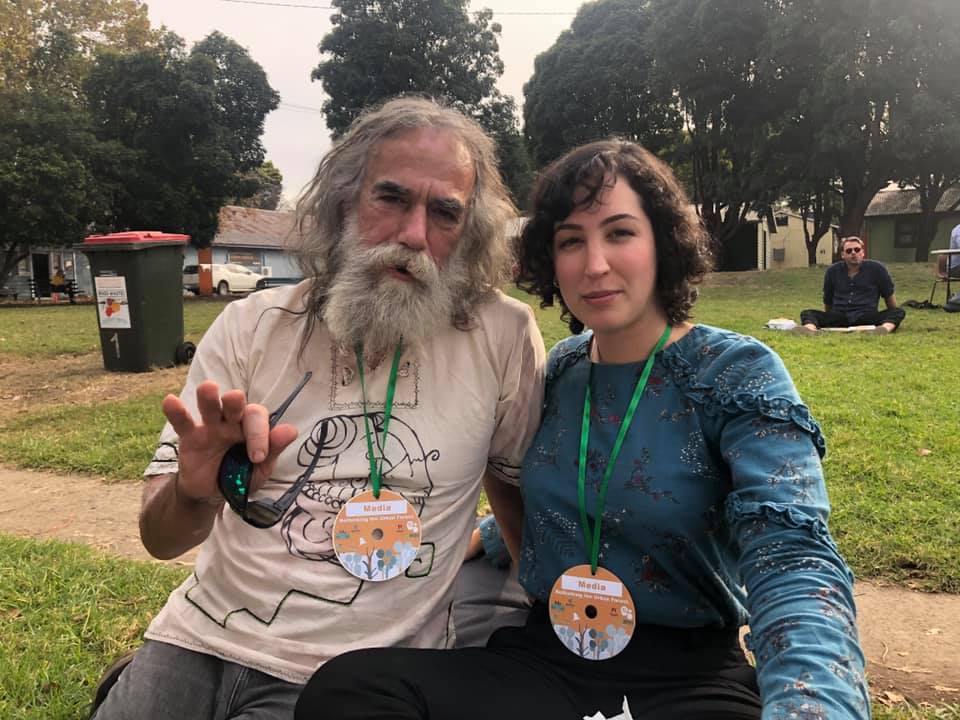
Radio 2SER-FM’s Weekend Breakfast team, Fabian Vernon and Julia Carr-Catzel, reporting on Rethinking the Urban Forest; “There are enough ideas here for a year’s worth of podcasts. It’s very rich.”

Delegates at Rethinking the Urban Forest take a break outside the Gumbramorra Hall at Addison Road Community Centre. Photo by Bruce Knobloch.
*
Dr Marco Amati, Associate Professor in International Planning at RMIT University spoke about the possibility of trees having legal standing, even ‘legal personhood’, an idea inspired by indigenous views that could be incorporated into legislation. “It gives a presence in the imagination of people” and “it gives trees a formal voice”.
He noted how we have gone from “planted Australian suburbs” of the post-War period “to a different kind of Australian dream”, more built up and denser, “an unregulated death by a 1000 cuts to the urban forest.” Its something that requires not only better planning and community engagement, it demands legal solutions as well.
*
Michael Sullings, arborist and Tree Management Officer for City of Sydney made one of the more powerful statements of the day: “Trees are useful beyond their death for a long, long time.”
Sullings spoke of developments in what he called ‘environmental arboriculture’ and “getting people to see trees in a different way. Not as a hazard or a nuisance that can drop leaves or branches, but as a house for animals and birds and living creatures.”
He explained that there has been a tendency “to have urban trees removed too soon”. And how “the removal of dead wood and dead trees is affecting bio-diversity in extremely negative ways across Sydney.” Sullings has been working on creating new “minimum industry standards for environmental arboriculture” and simply “looking at trees differently, and looking at different management options”.
A dead or dying tree can still be a vital habitat. And a wonderful asset if cared for in the right way.
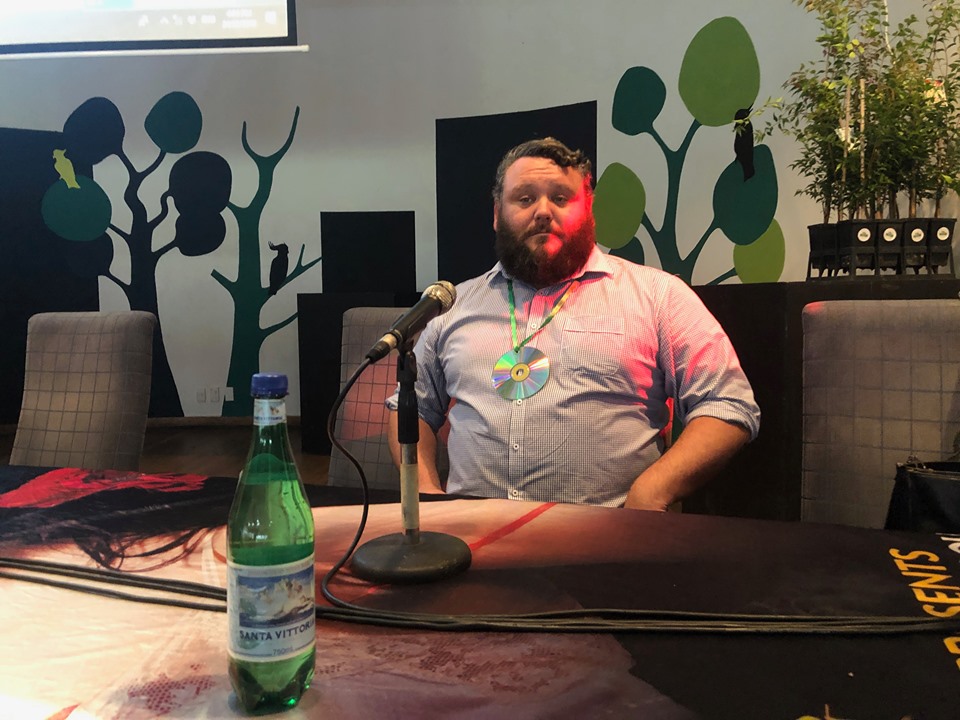
Michael Sullings, arborist and Tree Management Officer for City of Sydney at Rethinking the Urban Forest

Abigail Douglas (seated) from Wilkins Public School launches our first children’s book, The Hollow Tree.
*
The Living Future Institute of Australia are interested in encouraging “socially rich, culturally rich, ecologically restorative” design and architecture. Its CEO Laura Hamilton-O’Hara discussed “the Living Building Challenge” which is, effectively, “the world’s most rigorous standard for building. We don’t look at ‘sustainability’ – in fact we joke that it is almost a dirty word in our office – we are looking at ‘regenerative’. Buildings that support a minimum of 105% of their energy or more.”
This involves a standard that goes beyond the structure and functionality of any building, examining supply chains and checking “every single thing that comes into a building, right down to the screws”.
It’s all associated with a philosophy called ‘Biophilic Design’, as pioneered by thinkers like Stephen R. Kellert. Drawing from this philosophy, Living Future are currently engaged in a major shopping centre project in Melbourne, where it is looking at everything from availability of natural light to “the supply chains for a nail salon’”. It’s a little known fact, Hamilton-O’Hara explains, but toxicity of certain chemical agents is suggesting links between infertility and women who work in nail salons.
In terms of office spaces and health and well-being, Hamilton-O’Hara spoke of “gains in cognitive functionality and performance. That all improves with even five minutes a day contact with nature. Simply seeing the colour green on a plant or a tree affects everything from health to absenteeism to overall performance.”

Laura Hamilton-O’Hara, Social Ecologist and CEO of Living Future Institute Australia; Warren Roberts, CEO and Founder of Living Legacy Forest; Graham Chalcroft, Public Artist and Designer, Founder of Verterbrae.
*
The likelihood of being injured by a falling branch or tree is 1 in 2,800,000. Meaning some 8 accident and emergency cases in Australia (accidents requiring hospital care) in the five years from 2010-to-2015 compared to 2,400 cases involving wheelie bins. John Douglas, the Head Teacher in Arboriculture at Ryde TAFE and Acting Commissioner for the Land and Environment Court is not sure why wheelie bins are such dangerous things in Australia. But he believes such statistics indicate the dangers of trees are somewhat overrated.
“I love trees, but…” is a common refrain, Douglas says, whenever he tries to argue in favour of keeping trees. “The mess trees cause can be a major complaint. Some people’s messiness gene is perhaps overdeveloped…. it can be so hard to persuade people that cutting down a tree will cause a loss of shade and privacy.”
Big trees are especially precious, Douglas says, “along with the big canopy they bring. Their amazing shapes aren’t random. They are magnificent bio-mechanical structures that strengthen and thicken trunks, branches and roots in response to the wind and gravity and other forces acting upon them. In their growth and girth they are strengthened.”
He acknowledged some tragic cases had occurred, one awful case recently involving a young girl. But the 1000s of trees across the state that were cut down in the wake of that tragedy was a massive overreaction without regard to any real dangers at all. “We want the asset of a tree to be recognised – and the risk assessed,” he emphasised. And with that “a record kept” that is ongoing. This requires well-trained arborists working actively with local councils; people able to “read” a tree, “who can see what is plausible in the branch formation structure and the forces of wind and gravity acting on any tree.”
This was the best and most sensible way to go forward rather than chopping trees down indiscriminately. And losing all the benefits they bring.
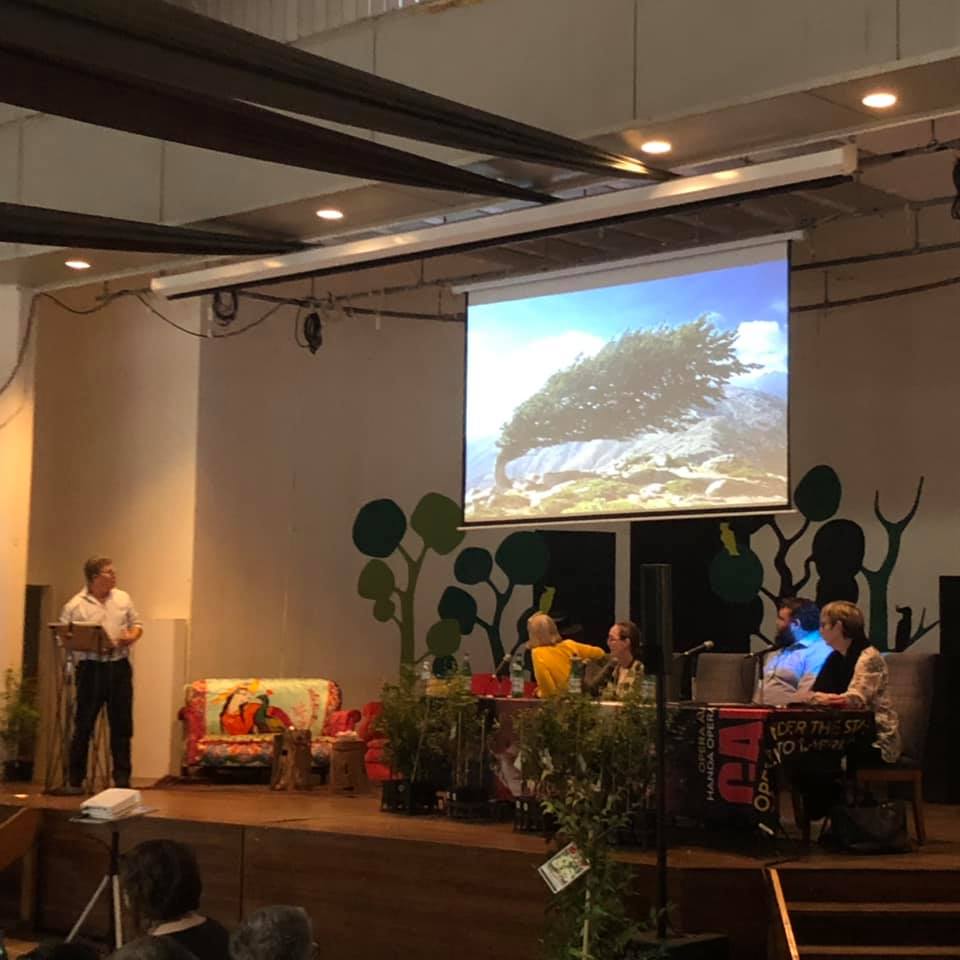
John Douglas, Head Teacher in Arboriculture at Ryde TAFE and Acting Commissioner at the Land and Environment Court: “Big trees are magnificent bio-mechanical structures.” Rethinking the Urban Forest. Photo by Bruce Knobloch.

John Douglas, Head Teacher in Arboriculture at Ryde TAFE and Acting Commissioner at the Land and Environment Court addresses Rethinking the Urban Forest. Our ‘Taking Root’ noticeboard in foreground grows more thoughts along the way.
*
“Our cities are modified ecosystems. They’re fundamentally changed and changing on a day-to-day basis. Every day we are growing. In essence that just means we are clearing more land.”
So says Peter Davies, Head of the Department of Environmental Sciences and an Executive Member of Macquarie University’s Smart Green Cities Research Centre. He showed an aerial photo and a satellite image to demonstrate what he meant. “You can see the green bits are declining. A lot of the [urban] growth is occurring in Western Sydney.”
Davies examined “the fragile premises” behind much urban planning and what limited environmental thinking is present, which “really means we’re just losing habitat and green spaces at a slower rate. But we are still losing it.” According to Davies’ analysis, a big problem lies in “planning focussed on development as an asset, but very little thinking that is strategic. We’re not being very clever.”
Simply tracking what is happening falls away very easily at the development level as projects progress. Davies gave this example: “An architect might have a vision. Look at my wonderful green vision. They get permissions from councils and other bodies. Along the way to it being developed the money runs out. And suddenly the green bits fall off first. Eventually you have a non-green landscape. The notion of amenity has gone.”
But it’s not just these large scale developments that matter, Davies says. The nature of our homes and what we do with them does count for something. “Gardens matter. A little green turf matters. Turf is not the best thing, but it’s a far better proposition than concrete. Every little bit matters,” he says.
The bridge to this thinking lies in preserving small pockets of bushland and parkland in urban environments. As we lose those oases, we get ourselves into very deep trouble in our cities, destroying micro habitats and affecting bio-diversity in ways that cannot be healed.
This awareness was reinforced earlier in the day by Jennifer Newman, a Wiraadjuri woman and academic who choose to read a poem called ‘Seasonal Revelations’ by the Australian poet, Romaine Norton: “Great trees do not grow overnight.”
*
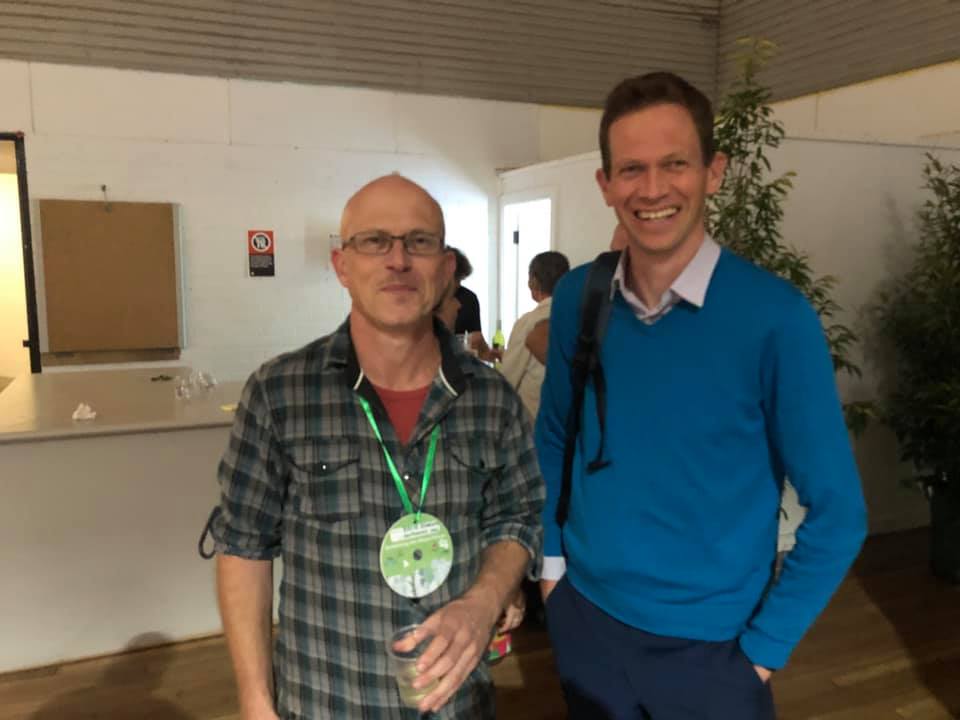
Bruce Knobloch, Conference Organiser for Rethinking the Urban Forest and guest speaker, David Callow, Team Leader, Urban Forest and Ecology, City of Melbourne. A good day’s work.
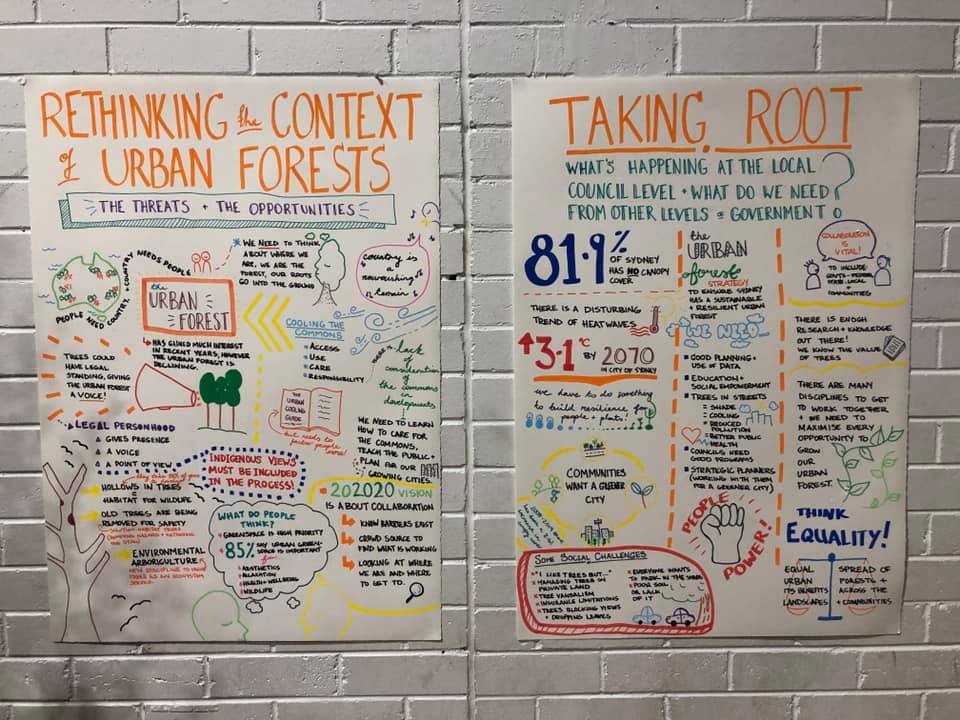
Maps of meaning from the Rethinking the Urban Forest conference. Texta touches and rapid insights drawn by Jayda Bicer. “The rest,” she says, “are yet to come.”

Mina Bui-Jones looking after our children’s book The Hollow Tree. Almost sold out on our first day. More printing!
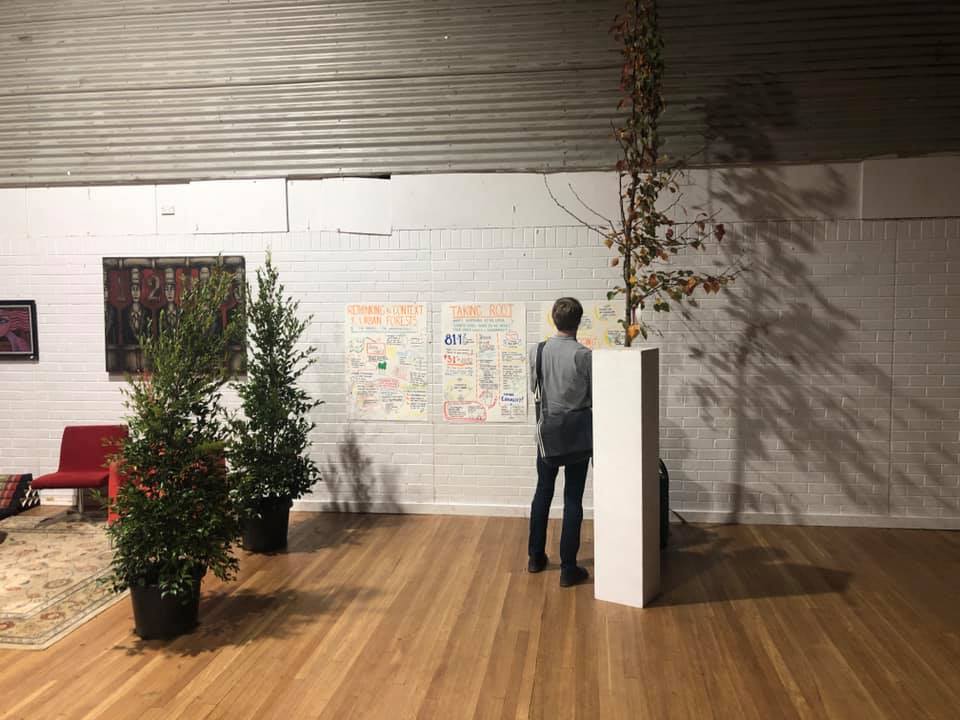
End of day. Tree of knowledge.
Rethinking the Urban Forest was initiated and presented by Addison Road Community Centre Organisation. A special thanks to our sponsor Andreasens Green Wholesale Nurseries. And our partners Inner West Council, Macquarie University, ArborSafe, Andreasens Green and 202020 Vision.

